E-Learning Quality: Strategies, Benefits, and Challenges in Education
VerifiedAdded on 2023/06/04
|24
|6626
|208
Essay
AI Summary
This essay explores the quality of e-learning in educational institutions, highlighting the increasing importance and deployment of e-learning across various forms of education. It emphasizes the need to focus on e-learning quality and strategies for its enhancement, covering technological, pedagogical, and learning style challenges. The literature review defines e-learning, discusses its benefits such as affordability and convenience, and identifies strategies for improving quality by overcoming technological obstacles. The study also addresses the strategic role of e-learning in institutions, aligning individual development with institutional goals, and identifies leadership, culture, and institutional challenges as key factors. The conclusion summarizes the discussion, reinforcing the potential of e-learning to provide accessible, affordable, and convenient education, provided that quality is prioritized and technological challenges are addressed.
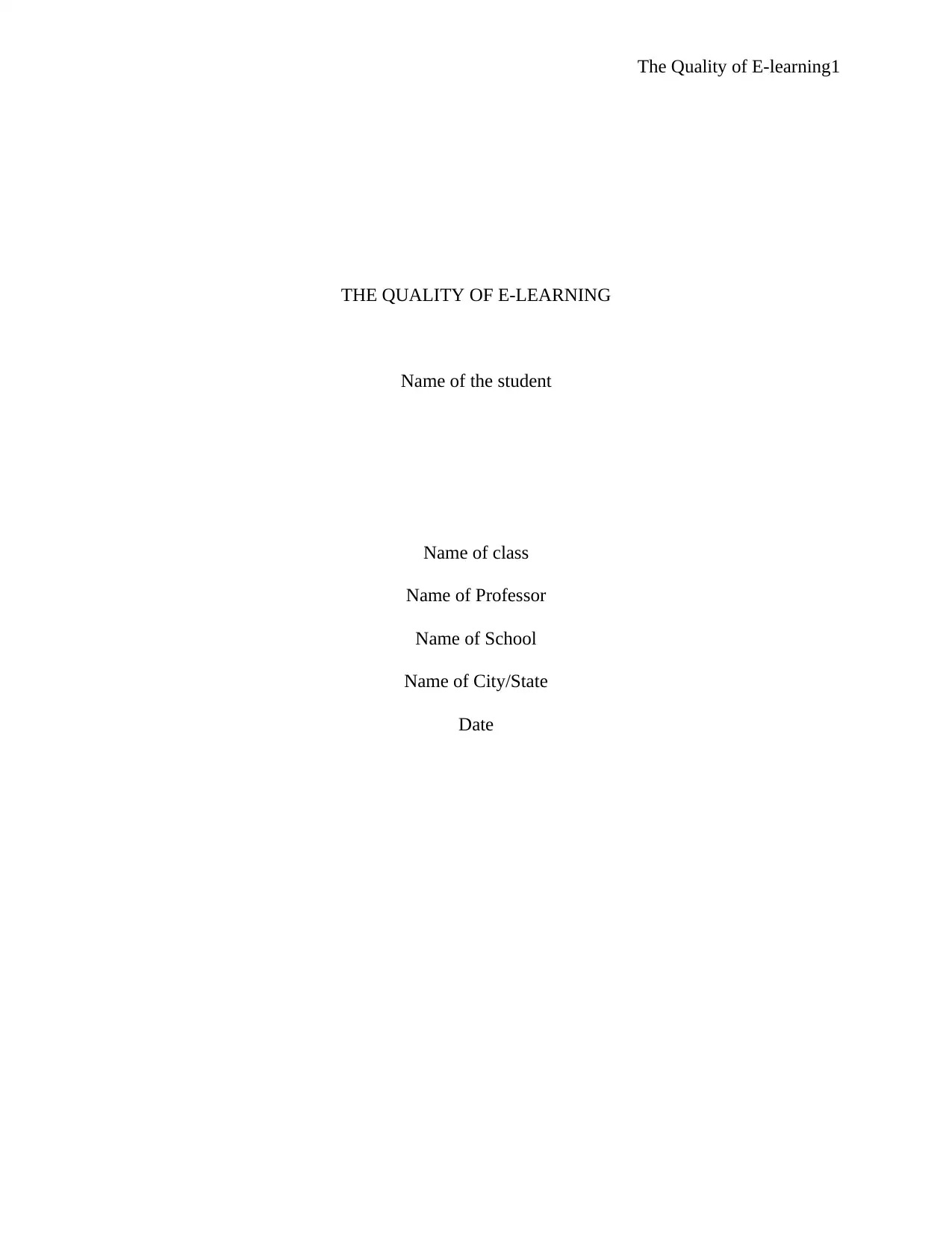
The Quality of E-learning1
THE QUALITY OF E-LEARNING
Name of the student
Name of class
Name of Professor
Name of School
Name of City/State
Date
THE QUALITY OF E-LEARNING
Name of the student
Name of class
Name of Professor
Name of School
Name of City/State
Date
Paraphrase This Document
Need a fresh take? Get an instant paraphrase of this document with our AI Paraphraser
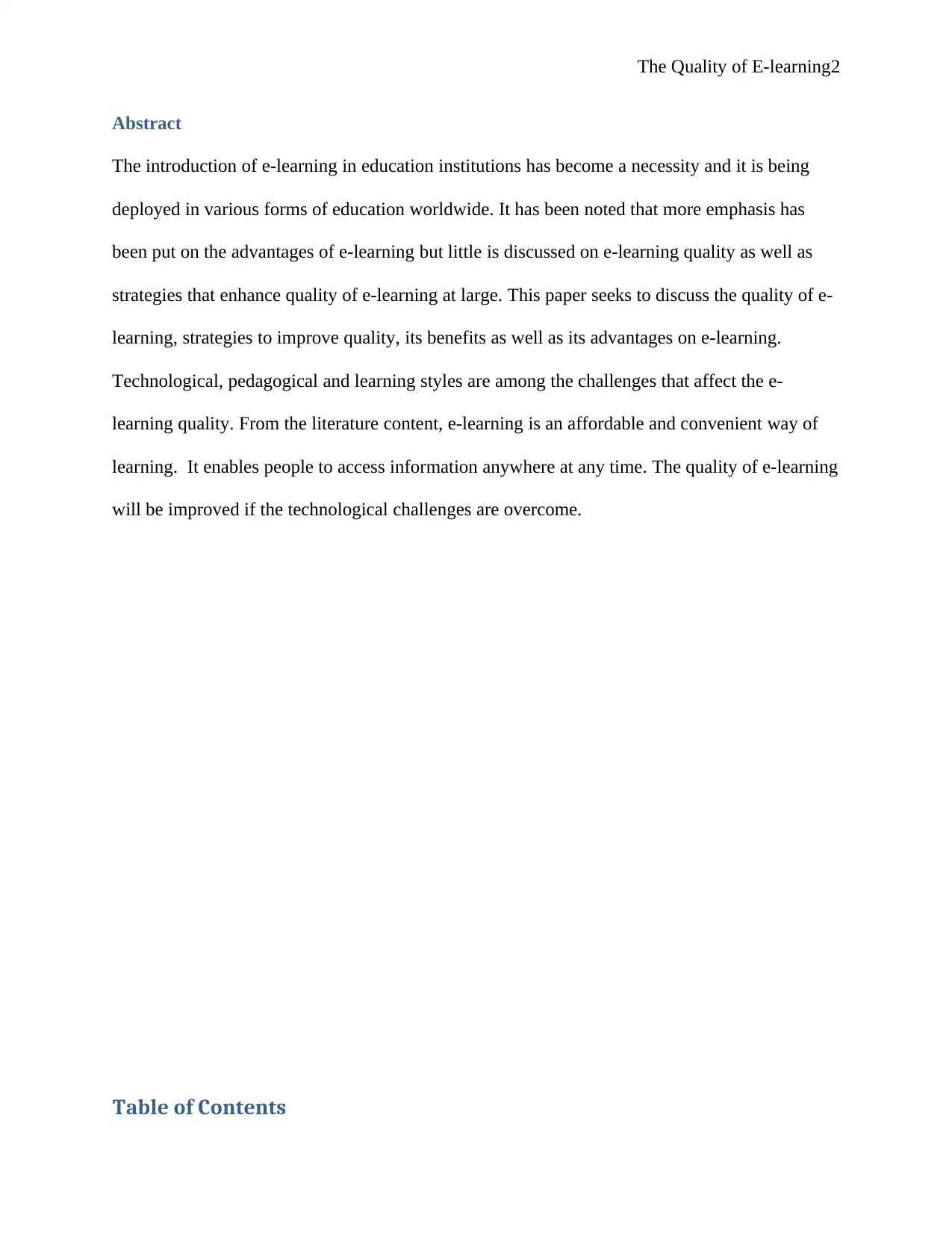
The Quality of E-learning2
Abstract
The introduction of e-learning in education institutions has become a necessity and it is being
deployed in various forms of education worldwide. It has been noted that more emphasis has
been put on the advantages of e-learning but little is discussed on e-learning quality as well as
strategies that enhance quality of e-learning at large. This paper seeks to discuss the quality of e-
learning, strategies to improve quality, its benefits as well as its advantages on e-learning.
Technological, pedagogical and learning styles are among the challenges that affect the e-
learning quality. From the literature content, e-learning is an affordable and convenient way of
learning. It enables people to access information anywhere at any time. The quality of e-learning
will be improved if the technological challenges are overcome.
Table of Contents
Abstract
The introduction of e-learning in education institutions has become a necessity and it is being
deployed in various forms of education worldwide. It has been noted that more emphasis has
been put on the advantages of e-learning but little is discussed on e-learning quality as well as
strategies that enhance quality of e-learning at large. This paper seeks to discuss the quality of e-
learning, strategies to improve quality, its benefits as well as its advantages on e-learning.
Technological, pedagogical and learning styles are among the challenges that affect the e-
learning quality. From the literature content, e-learning is an affordable and convenient way of
learning. It enables people to access information anywhere at any time. The quality of e-learning
will be improved if the technological challenges are overcome.
Table of Contents
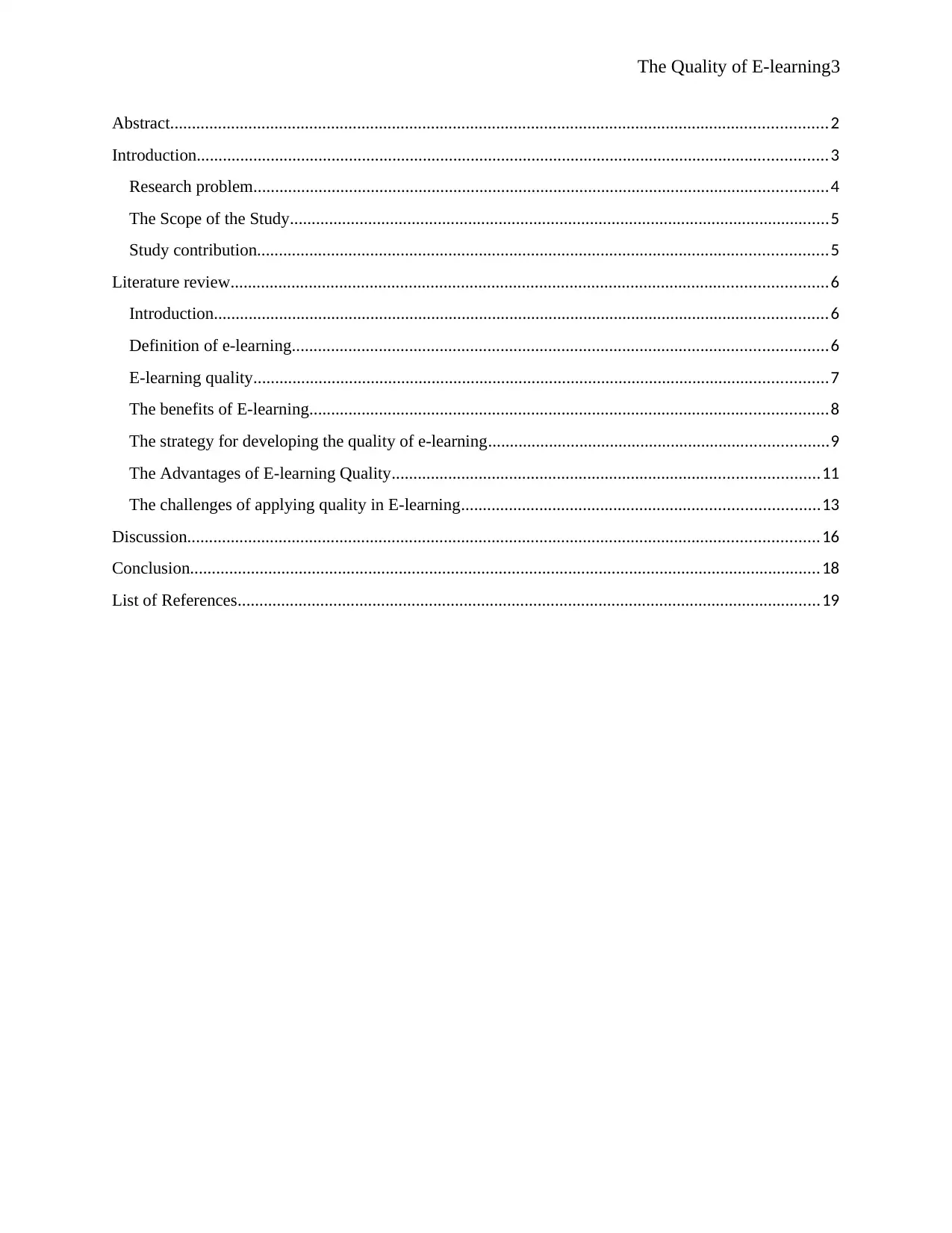
The Quality of E-learning3
Abstract.......................................................................................................................................................2
Introduction.................................................................................................................................................3
Research problem....................................................................................................................................4
The Scope of the Study............................................................................................................................5
Study contribution...................................................................................................................................5
Literature review.........................................................................................................................................6
Introduction.............................................................................................................................................6
Definition of e-learning...........................................................................................................................6
E-learning quality....................................................................................................................................7
The benefits of E-learning.......................................................................................................................8
The strategy for developing the quality of e-learning..............................................................................9
The Advantages of E-learning Quality..................................................................................................11
The challenges of applying quality in E-learning..................................................................................13
Discussion.................................................................................................................................................16
Conclusion.................................................................................................................................................18
List of References......................................................................................................................................19
Abstract.......................................................................................................................................................2
Introduction.................................................................................................................................................3
Research problem....................................................................................................................................4
The Scope of the Study............................................................................................................................5
Study contribution...................................................................................................................................5
Literature review.........................................................................................................................................6
Introduction.............................................................................................................................................6
Definition of e-learning...........................................................................................................................6
E-learning quality....................................................................................................................................7
The benefits of E-learning.......................................................................................................................8
The strategy for developing the quality of e-learning..............................................................................9
The Advantages of E-learning Quality..................................................................................................11
The challenges of applying quality in E-learning..................................................................................13
Discussion.................................................................................................................................................16
Conclusion.................................................................................................................................................18
List of References......................................................................................................................................19
⊘ This is a preview!⊘
Do you want full access?
Subscribe today to unlock all pages.

Trusted by 1+ million students worldwide
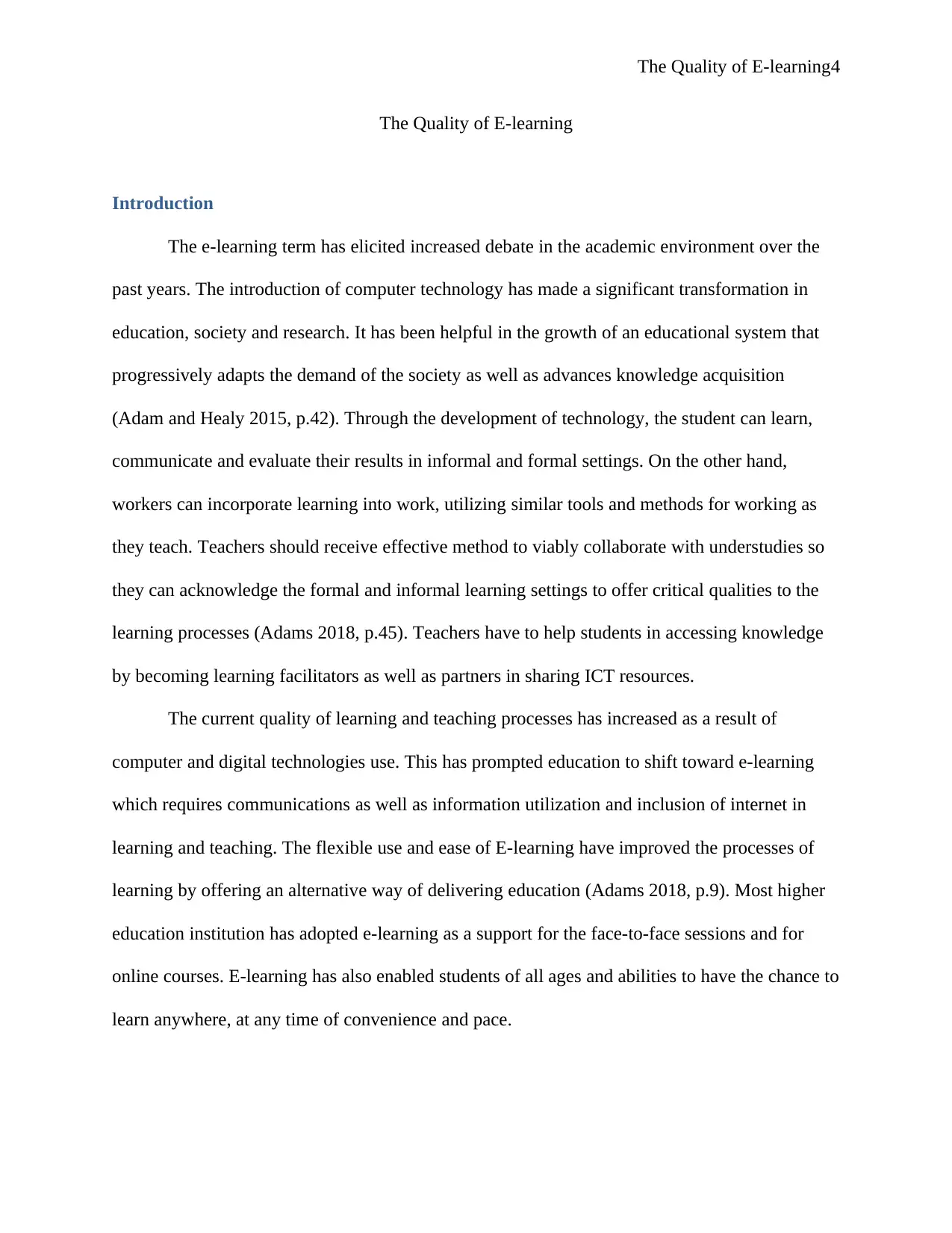
The Quality of E-learning4
The Quality of E-learning
Introduction
The e-learning term has elicited increased debate in the academic environment over the
past years. The introduction of computer technology has made a significant transformation in
education, society and research. It has been helpful in the growth of an educational system that
progressively adapts the demand of the society as well as advances knowledge acquisition
(Adam and Healy 2015, p.42). Through the development of technology, the student can learn,
communicate and evaluate their results in informal and formal settings. On the other hand,
workers can incorporate learning into work, utilizing similar tools and methods for working as
they teach. Teachers should receive effective method to viably collaborate with understudies so
they can acknowledge the formal and informal learning settings to offer critical qualities to the
learning processes (Adams 2018, p.45). Teachers have to help students in accessing knowledge
by becoming learning facilitators as well as partners in sharing ICT resources.
The current quality of learning and teaching processes has increased as a result of
computer and digital technologies use. This has prompted education to shift toward e-learning
which requires communications as well as information utilization and inclusion of internet in
learning and teaching. The flexible use and ease of E-learning have improved the processes of
learning by offering an alternative way of delivering education (Adams 2018, p.9). Most higher
education institution has adopted e-learning as a support for the face-to-face sessions and for
online courses. E-learning has also enabled students of all ages and abilities to have the chance to
learn anywhere, at any time of convenience and pace.
The Quality of E-learning
Introduction
The e-learning term has elicited increased debate in the academic environment over the
past years. The introduction of computer technology has made a significant transformation in
education, society and research. It has been helpful in the growth of an educational system that
progressively adapts the demand of the society as well as advances knowledge acquisition
(Adam and Healy 2015, p.42). Through the development of technology, the student can learn,
communicate and evaluate their results in informal and formal settings. On the other hand,
workers can incorporate learning into work, utilizing similar tools and methods for working as
they teach. Teachers should receive effective method to viably collaborate with understudies so
they can acknowledge the formal and informal learning settings to offer critical qualities to the
learning processes (Adams 2018, p.45). Teachers have to help students in accessing knowledge
by becoming learning facilitators as well as partners in sharing ICT resources.
The current quality of learning and teaching processes has increased as a result of
computer and digital technologies use. This has prompted education to shift toward e-learning
which requires communications as well as information utilization and inclusion of internet in
learning and teaching. The flexible use and ease of E-learning have improved the processes of
learning by offering an alternative way of delivering education (Adams 2018, p.9). Most higher
education institution has adopted e-learning as a support for the face-to-face sessions and for
online courses. E-learning has also enabled students of all ages and abilities to have the chance to
learn anywhere, at any time of convenience and pace.
Paraphrase This Document
Need a fresh take? Get an instant paraphrase of this document with our AI Paraphraser
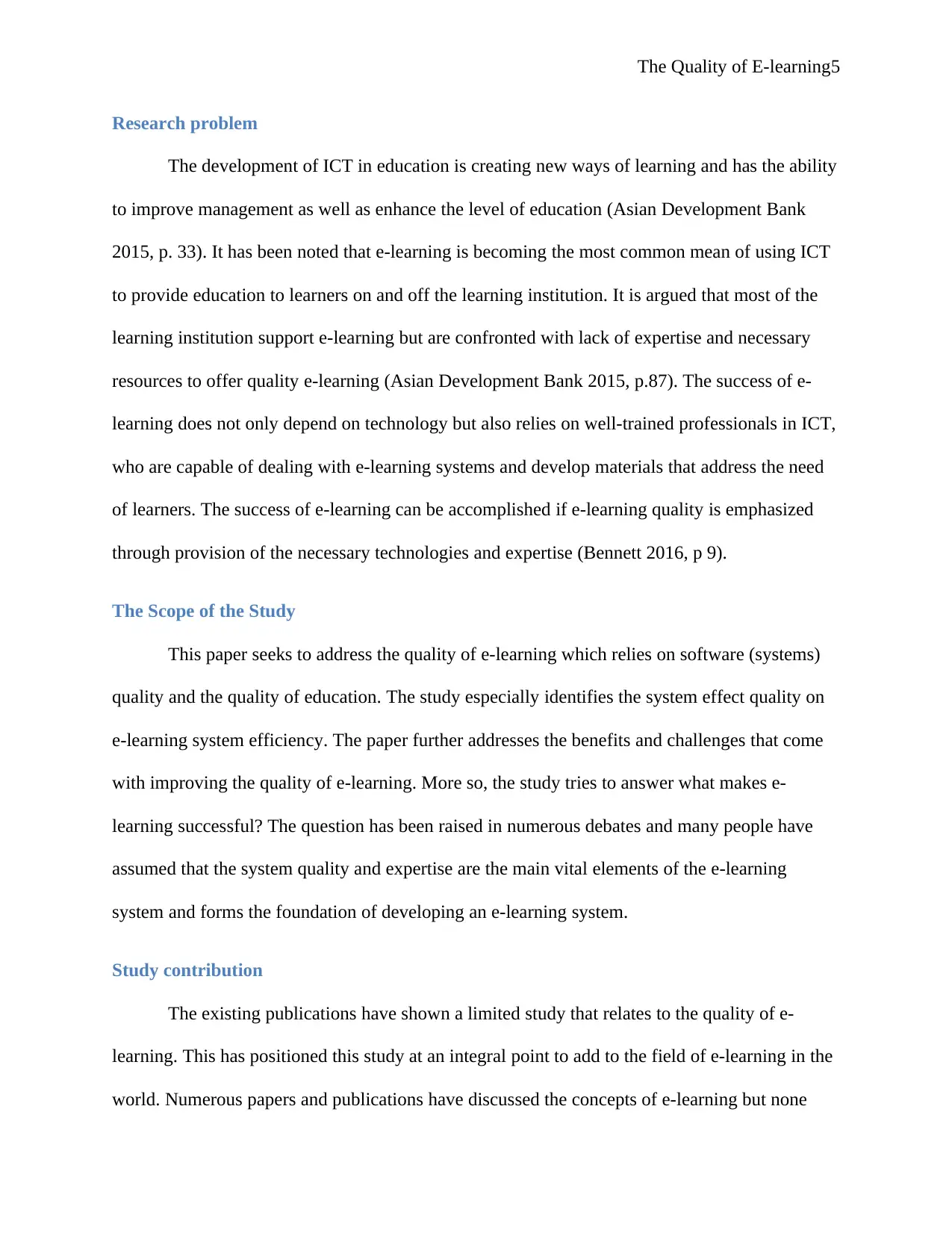
The Quality of E-learning5
Research problem
The development of ICT in education is creating new ways of learning and has the ability
to improve management as well as enhance the level of education (Asian Development Bank
2015, p. 33). It has been noted that e-learning is becoming the most common mean of using ICT
to provide education to learners on and off the learning institution. It is argued that most of the
learning institution support e-learning but are confronted with lack of expertise and necessary
resources to offer quality e-learning (Asian Development Bank 2015, p.87). The success of e-
learning does not only depend on technology but also relies on well-trained professionals in ICT,
who are capable of dealing with e-learning systems and develop materials that address the need
of learners. The success of e-learning can be accomplished if e-learning quality is emphasized
through provision of the necessary technologies and expertise (Bennett 2016, p 9).
The Scope of the Study
This paper seeks to address the quality of e-learning which relies on software (systems)
quality and the quality of education. The study especially identifies the system effect quality on
e-learning system efficiency. The paper further addresses the benefits and challenges that come
with improving the quality of e-learning. More so, the study tries to answer what makes e-
learning successful? The question has been raised in numerous debates and many people have
assumed that the system quality and expertise are the main vital elements of the e-learning
system and forms the foundation of developing an e-learning system.
Study contribution
The existing publications have shown a limited study that relates to the quality of e-
learning. This has positioned this study at an integral point to add to the field of e-learning in the
world. Numerous papers and publications have discussed the concepts of e-learning but none
Research problem
The development of ICT in education is creating new ways of learning and has the ability
to improve management as well as enhance the level of education (Asian Development Bank
2015, p. 33). It has been noted that e-learning is becoming the most common mean of using ICT
to provide education to learners on and off the learning institution. It is argued that most of the
learning institution support e-learning but are confronted with lack of expertise and necessary
resources to offer quality e-learning (Asian Development Bank 2015, p.87). The success of e-
learning does not only depend on technology but also relies on well-trained professionals in ICT,
who are capable of dealing with e-learning systems and develop materials that address the need
of learners. The success of e-learning can be accomplished if e-learning quality is emphasized
through provision of the necessary technologies and expertise (Bennett 2016, p 9).
The Scope of the Study
This paper seeks to address the quality of e-learning which relies on software (systems)
quality and the quality of education. The study especially identifies the system effect quality on
e-learning system efficiency. The paper further addresses the benefits and challenges that come
with improving the quality of e-learning. More so, the study tries to answer what makes e-
learning successful? The question has been raised in numerous debates and many people have
assumed that the system quality and expertise are the main vital elements of the e-learning
system and forms the foundation of developing an e-learning system.
Study contribution
The existing publications have shown a limited study that relates to the quality of e-
learning. This has positioned this study at an integral point to add to the field of e-learning in the
world. Numerous papers and publications have discussed the concepts of e-learning but none
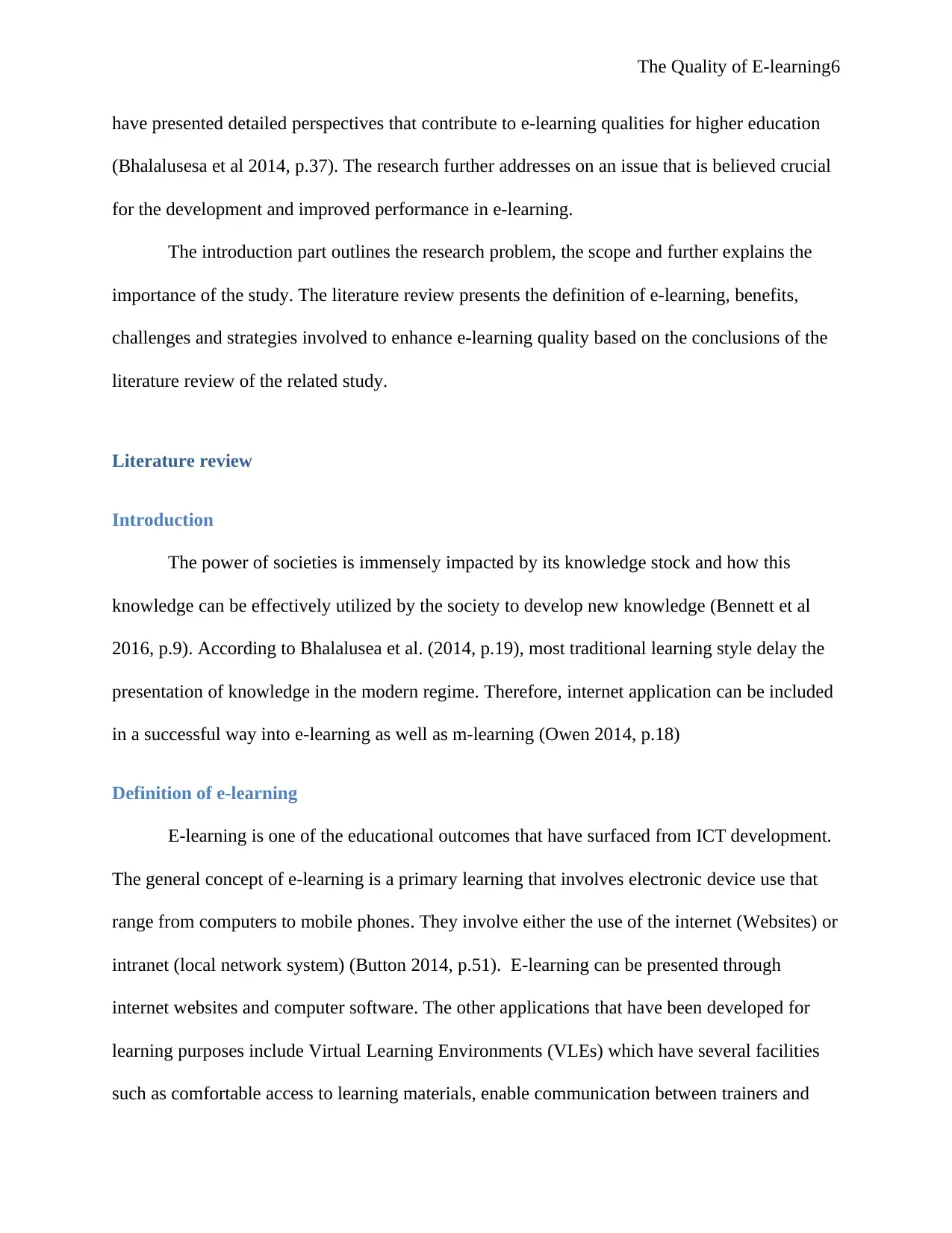
The Quality of E-learning6
have presented detailed perspectives that contribute to e-learning qualities for higher education
(Bhalalusesa et al 2014, p.37). The research further addresses on an issue that is believed crucial
for the development and improved performance in e-learning.
The introduction part outlines the research problem, the scope and further explains the
importance of the study. The literature review presents the definition of e-learning, benefits,
challenges and strategies involved to enhance e-learning quality based on the conclusions of the
literature review of the related study.
Literature review
Introduction
The power of societies is immensely impacted by its knowledge stock and how this
knowledge can be effectively utilized by the society to develop new knowledge (Bennett et al
2016, p.9). According to Bhalalusea et al. (2014, p.19), most traditional learning style delay the
presentation of knowledge in the modern regime. Therefore, internet application can be included
in a successful way into e-learning as well as m-learning (Owen 2014, p.18)
Definition of e-learning
E-learning is one of the educational outcomes that have surfaced from ICT development.
The general concept of e-learning is a primary learning that involves electronic device use that
range from computers to mobile phones. They involve either the use of the internet (Websites) or
intranet (local network system) (Button 2014, p.51). E-learning can be presented through
internet websites and computer software. The other applications that have been developed for
learning purposes include Virtual Learning Environments (VLEs) which have several facilities
such as comfortable access to learning materials, enable communication between trainers and
have presented detailed perspectives that contribute to e-learning qualities for higher education
(Bhalalusesa et al 2014, p.37). The research further addresses on an issue that is believed crucial
for the development and improved performance in e-learning.
The introduction part outlines the research problem, the scope and further explains the
importance of the study. The literature review presents the definition of e-learning, benefits,
challenges and strategies involved to enhance e-learning quality based on the conclusions of the
literature review of the related study.
Literature review
Introduction
The power of societies is immensely impacted by its knowledge stock and how this
knowledge can be effectively utilized by the society to develop new knowledge (Bennett et al
2016, p.9). According to Bhalalusea et al. (2014, p.19), most traditional learning style delay the
presentation of knowledge in the modern regime. Therefore, internet application can be included
in a successful way into e-learning as well as m-learning (Owen 2014, p.18)
Definition of e-learning
E-learning is one of the educational outcomes that have surfaced from ICT development.
The general concept of e-learning is a primary learning that involves electronic device use that
range from computers to mobile phones. They involve either the use of the internet (Websites) or
intranet (local network system) (Button 2014, p.51). E-learning can be presented through
internet websites and computer software. The other applications that have been developed for
learning purposes include Virtual Learning Environments (VLEs) which have several facilities
such as comfortable access to learning materials, enable communication between trainers and
⊘ This is a preview!⊘
Do you want full access?
Subscribe today to unlock all pages.

Trusted by 1+ million students worldwide
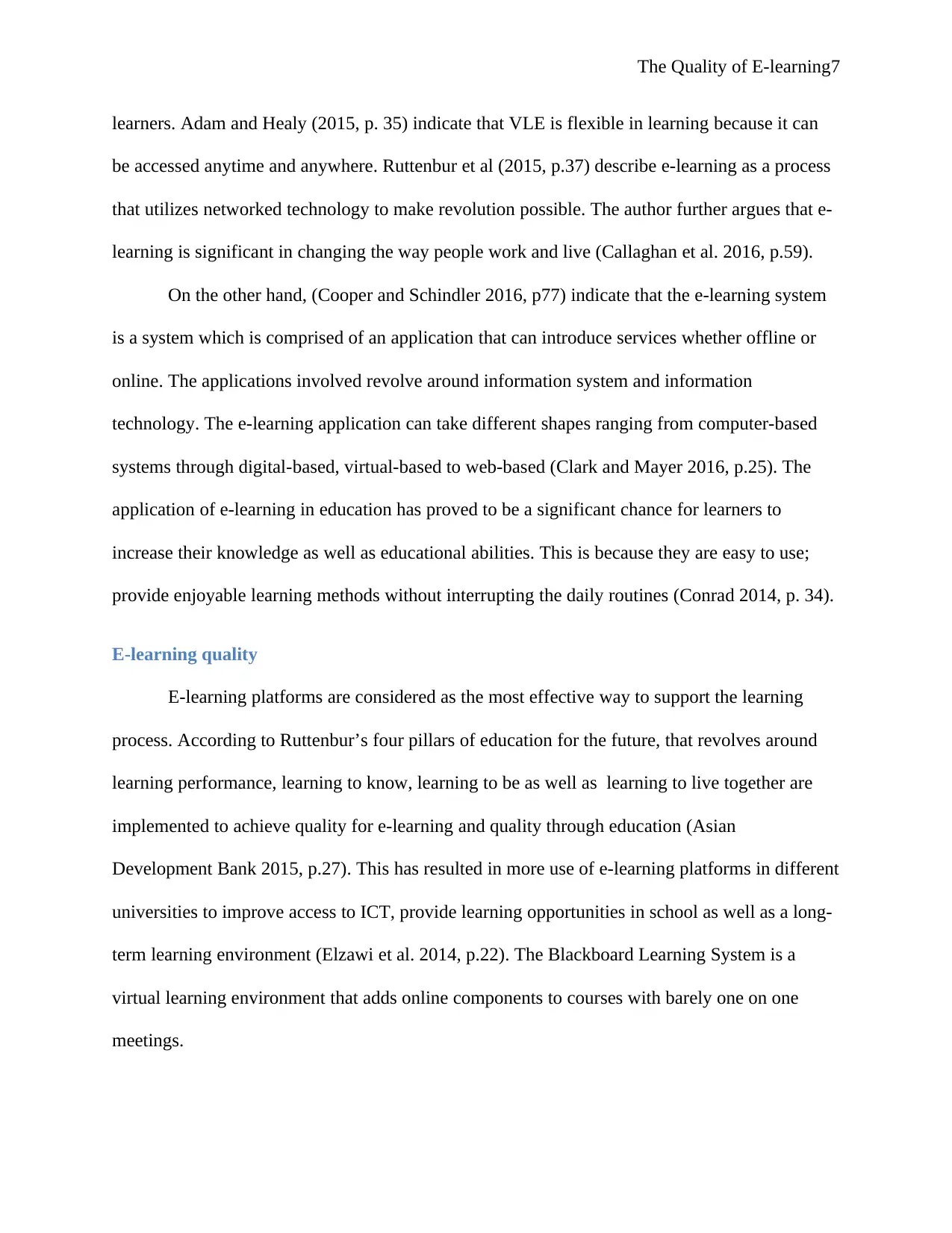
The Quality of E-learning7
learners. Adam and Healy (2015, p. 35) indicate that VLE is flexible in learning because it can
be accessed anytime and anywhere. Ruttenbur et al (2015, p.37) describe e-learning as a process
that utilizes networked technology to make revolution possible. The author further argues that e-
learning is significant in changing the way people work and live (Callaghan et al. 2016, p.59).
On the other hand, (Cooper and Schindler 2016, p77) indicate that the e-learning system
is a system which is comprised of an application that can introduce services whether offline or
online. The applications involved revolve around information system and information
technology. The e-learning application can take different shapes ranging from computer-based
systems through digital-based, virtual-based to web-based (Clark and Mayer 2016, p.25). The
application of e-learning in education has proved to be a significant chance for learners to
increase their knowledge as well as educational abilities. This is because they are easy to use;
provide enjoyable learning methods without interrupting the daily routines (Conrad 2014, p. 34).
E-learning quality
E-learning platforms are considered as the most effective way to support the learning
process. According to Ruttenbur’s four pillars of education for the future, that revolves around
learning performance, learning to know, learning to be as well as learning to live together are
implemented to achieve quality for e-learning and quality through education (Asian
Development Bank 2015, p.27). This has resulted in more use of e-learning platforms in different
universities to improve access to ICT, provide learning opportunities in school as well as a long-
term learning environment (Elzawi et al. 2014, p.22). The Blackboard Learning System is a
virtual learning environment that adds online components to courses with barely one on one
meetings.
learners. Adam and Healy (2015, p. 35) indicate that VLE is flexible in learning because it can
be accessed anytime and anywhere. Ruttenbur et al (2015, p.37) describe e-learning as a process
that utilizes networked technology to make revolution possible. The author further argues that e-
learning is significant in changing the way people work and live (Callaghan et al. 2016, p.59).
On the other hand, (Cooper and Schindler 2016, p77) indicate that the e-learning system
is a system which is comprised of an application that can introduce services whether offline or
online. The applications involved revolve around information system and information
technology. The e-learning application can take different shapes ranging from computer-based
systems through digital-based, virtual-based to web-based (Clark and Mayer 2016, p.25). The
application of e-learning in education has proved to be a significant chance for learners to
increase their knowledge as well as educational abilities. This is because they are easy to use;
provide enjoyable learning methods without interrupting the daily routines (Conrad 2014, p. 34).
E-learning quality
E-learning platforms are considered as the most effective way to support the learning
process. According to Ruttenbur’s four pillars of education for the future, that revolves around
learning performance, learning to know, learning to be as well as learning to live together are
implemented to achieve quality for e-learning and quality through education (Asian
Development Bank 2015, p.27). This has resulted in more use of e-learning platforms in different
universities to improve access to ICT, provide learning opportunities in school as well as a long-
term learning environment (Elzawi et al. 2014, p.22). The Blackboard Learning System is a
virtual learning environment that adds online components to courses with barely one on one
meetings.
Paraphrase This Document
Need a fresh take? Get an instant paraphrase of this document with our AI Paraphraser
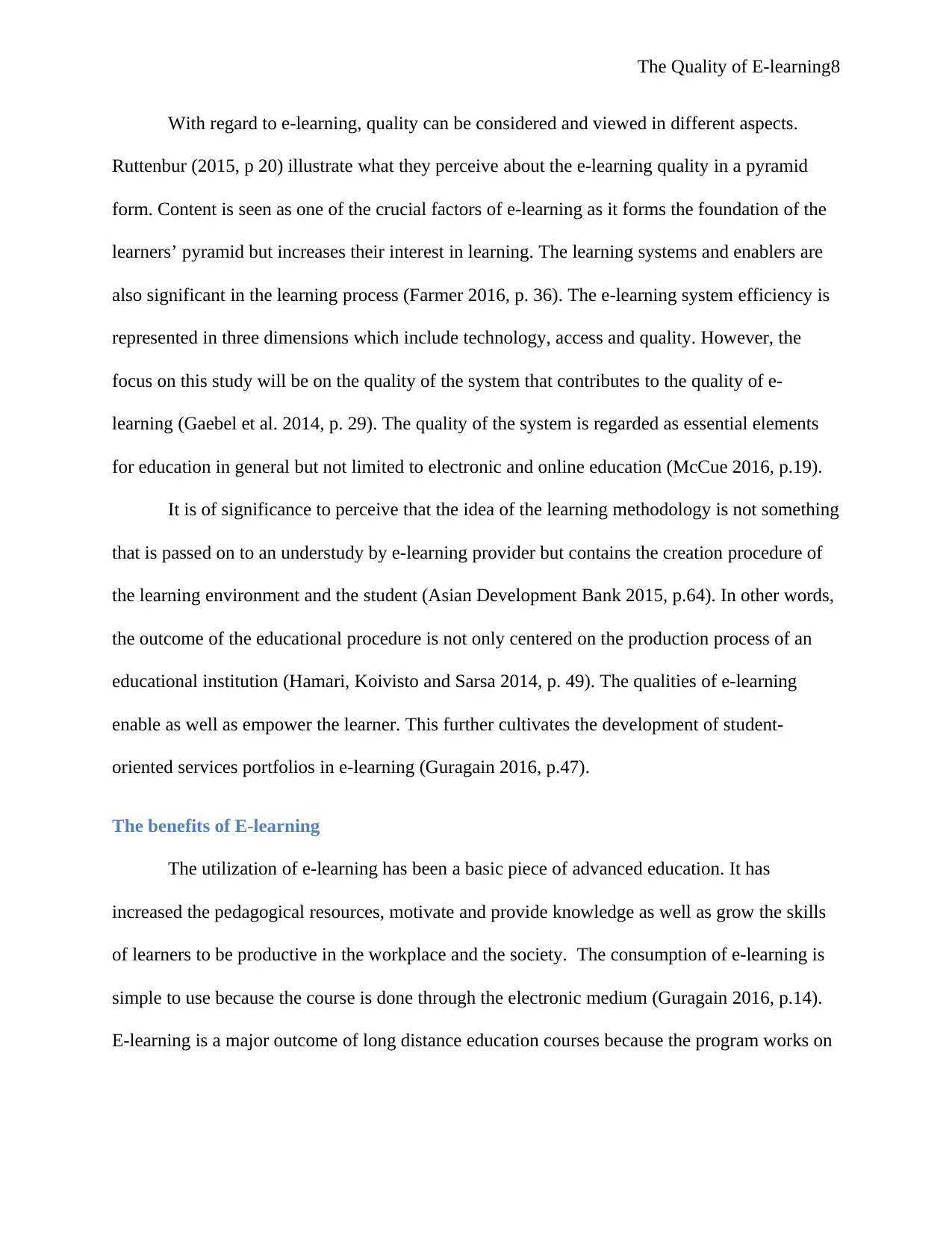
The Quality of E-learning8
With regard to e-learning, quality can be considered and viewed in different aspects.
Ruttenbur (2015, p 20) illustrate what they perceive about the e-learning quality in a pyramid
form. Content is seen as one of the crucial factors of e-learning as it forms the foundation of the
learners’ pyramid but increases their interest in learning. The learning systems and enablers are
also significant in the learning process (Farmer 2016, p. 36). The e-learning system efficiency is
represented in three dimensions which include technology, access and quality. However, the
focus on this study will be on the quality of the system that contributes to the quality of e-
learning (Gaebel et al. 2014, p. 29). The quality of the system is regarded as essential elements
for education in general but not limited to electronic and online education (McCue 2016, p.19).
It is of significance to perceive that the idea of the learning methodology is not something
that is passed on to an understudy by e-learning provider but contains the creation procedure of
the learning environment and the student (Asian Development Bank 2015, p.64). In other words,
the outcome of the educational procedure is not only centered on the production process of an
educational institution (Hamari, Koivisto and Sarsa 2014, p. 49). The qualities of e-learning
enable as well as empower the learner. This further cultivates the development of student-
oriented services portfolios in e-learning (Guragain 2016, p.47).
The benefits of E-learning
The utilization of e-learning has been a basic piece of advanced education. It has
increased the pedagogical resources, motivate and provide knowledge as well as grow the skills
of learners to be productive in the workplace and the society. The consumption of e-learning is
simple to use because the course is done through the electronic medium (Guragain 2016, p.14).
E-learning is a major outcome of long distance education courses because the program works on
With regard to e-learning, quality can be considered and viewed in different aspects.
Ruttenbur (2015, p 20) illustrate what they perceive about the e-learning quality in a pyramid
form. Content is seen as one of the crucial factors of e-learning as it forms the foundation of the
learners’ pyramid but increases their interest in learning. The learning systems and enablers are
also significant in the learning process (Farmer 2016, p. 36). The e-learning system efficiency is
represented in three dimensions which include technology, access and quality. However, the
focus on this study will be on the quality of the system that contributes to the quality of e-
learning (Gaebel et al. 2014, p. 29). The quality of the system is regarded as essential elements
for education in general but not limited to electronic and online education (McCue 2016, p.19).
It is of significance to perceive that the idea of the learning methodology is not something
that is passed on to an understudy by e-learning provider but contains the creation procedure of
the learning environment and the student (Asian Development Bank 2015, p.64). In other words,
the outcome of the educational procedure is not only centered on the production process of an
educational institution (Hamari, Koivisto and Sarsa 2014, p. 49). The qualities of e-learning
enable as well as empower the learner. This further cultivates the development of student-
oriented services portfolios in e-learning (Guragain 2016, p.47).
The benefits of E-learning
The utilization of e-learning has been a basic piece of advanced education. It has
increased the pedagogical resources, motivate and provide knowledge as well as grow the skills
of learners to be productive in the workplace and the society. The consumption of e-learning is
simple to use because the course is done through the electronic medium (Guragain 2016, p.14).
E-learning is a major outcome of long distance education courses because the program works on
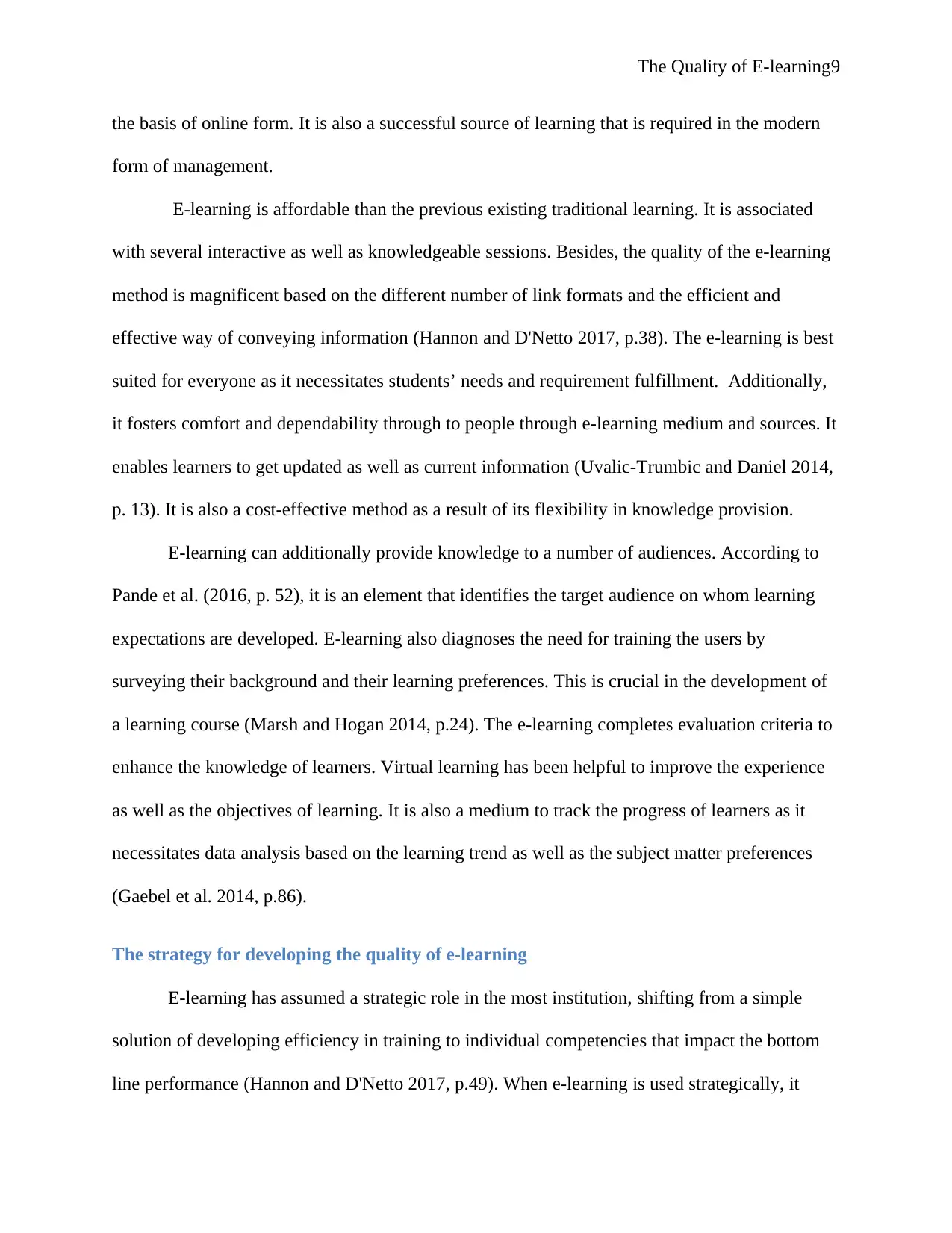
The Quality of E-learning9
the basis of online form. It is also a successful source of learning that is required in the modern
form of management.
E-learning is affordable than the previous existing traditional learning. It is associated
with several interactive as well as knowledgeable sessions. Besides, the quality of the e-learning
method is magnificent based on the different number of link formats and the efficient and
effective way of conveying information (Hannon and D'Netto 2017, p.38). The e-learning is best
suited for everyone as it necessitates students’ needs and requirement fulfillment. Additionally,
it fosters comfort and dependability through to people through e-learning medium and sources. It
enables learners to get updated as well as current information (Uvalic-Trumbic and Daniel 2014,
p. 13). It is also a cost-effective method as a result of its flexibility in knowledge provision.
E-learning can additionally provide knowledge to a number of audiences. According to
Pande et al. (2016, p. 52), it is an element that identifies the target audience on whom learning
expectations are developed. E-learning also diagnoses the need for training the users by
surveying their background and their learning preferences. This is crucial in the development of
a learning course (Marsh and Hogan 2014, p.24). The e-learning completes evaluation criteria to
enhance the knowledge of learners. Virtual learning has been helpful to improve the experience
as well as the objectives of learning. It is also a medium to track the progress of learners as it
necessitates data analysis based on the learning trend as well as the subject matter preferences
(Gaebel et al. 2014, p.86).
The strategy for developing the quality of e-learning
E-learning has assumed a strategic role in the most institution, shifting from a simple
solution of developing efficiency in training to individual competencies that impact the bottom
line performance (Hannon and D'Netto 2017, p.49). When e-learning is used strategically, it
the basis of online form. It is also a successful source of learning that is required in the modern
form of management.
E-learning is affordable than the previous existing traditional learning. It is associated
with several interactive as well as knowledgeable sessions. Besides, the quality of the e-learning
method is magnificent based on the different number of link formats and the efficient and
effective way of conveying information (Hannon and D'Netto 2017, p.38). The e-learning is best
suited for everyone as it necessitates students’ needs and requirement fulfillment. Additionally,
it fosters comfort and dependability through to people through e-learning medium and sources. It
enables learners to get updated as well as current information (Uvalic-Trumbic and Daniel 2014,
p. 13). It is also a cost-effective method as a result of its flexibility in knowledge provision.
E-learning can additionally provide knowledge to a number of audiences. According to
Pande et al. (2016, p. 52), it is an element that identifies the target audience on whom learning
expectations are developed. E-learning also diagnoses the need for training the users by
surveying their background and their learning preferences. This is crucial in the development of
a learning course (Marsh and Hogan 2014, p.24). The e-learning completes evaluation criteria to
enhance the knowledge of learners. Virtual learning has been helpful to improve the experience
as well as the objectives of learning. It is also a medium to track the progress of learners as it
necessitates data analysis based on the learning trend as well as the subject matter preferences
(Gaebel et al. 2014, p.86).
The strategy for developing the quality of e-learning
E-learning has assumed a strategic role in the most institution, shifting from a simple
solution of developing efficiency in training to individual competencies that impact the bottom
line performance (Hannon and D'Netto 2017, p.49). When e-learning is used strategically, it
⊘ This is a preview!⊘
Do you want full access?
Subscribe today to unlock all pages.

Trusted by 1+ million students worldwide
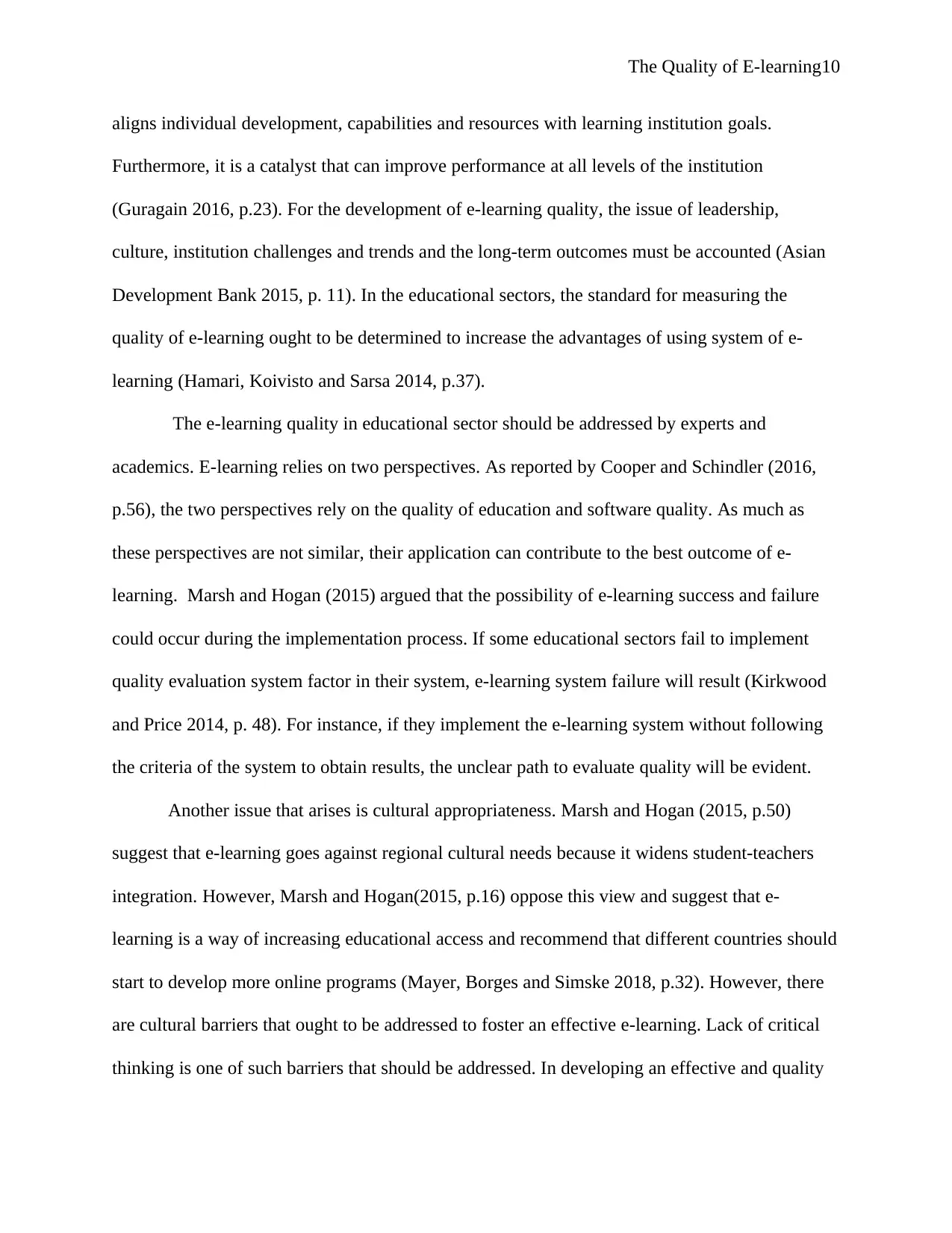
The Quality of E-learning10
aligns individual development, capabilities and resources with learning institution goals.
Furthermore, it is a catalyst that can improve performance at all levels of the institution
(Guragain 2016, p.23). For the development of e-learning quality, the issue of leadership,
culture, institution challenges and trends and the long-term outcomes must be accounted (Asian
Development Bank 2015, p. 11). In the educational sectors, the standard for measuring the
quality of e-learning ought to be determined to increase the advantages of using system of e-
learning (Hamari, Koivisto and Sarsa 2014, p.37).
The e-learning quality in educational sector should be addressed by experts and
academics. E-learning relies on two perspectives. As reported by Cooper and Schindler (2016,
p.56), the two perspectives rely on the quality of education and software quality. As much as
these perspectives are not similar, their application can contribute to the best outcome of e-
learning. Marsh and Hogan (2015) argued that the possibility of e-learning success and failure
could occur during the implementation process. If some educational sectors fail to implement
quality evaluation system factor in their system, e-learning system failure will result (Kirkwood
and Price 2014, p. 48). For instance, if they implement the e-learning system without following
the criteria of the system to obtain results, the unclear path to evaluate quality will be evident.
Another issue that arises is cultural appropriateness. Marsh and Hogan (2015, p.50)
suggest that e-learning goes against regional cultural needs because it widens student-teachers
integration. However, Marsh and Hogan(2015, p.16) oppose this view and suggest that e-
learning is a way of increasing educational access and recommend that different countries should
start to develop more online programs (Mayer, Borges and Simske 2018, p.32). However, there
are cultural barriers that ought to be addressed to foster an effective e-learning. Lack of critical
thinking is one of such barriers that should be addressed. In developing an effective and quality
aligns individual development, capabilities and resources with learning institution goals.
Furthermore, it is a catalyst that can improve performance at all levels of the institution
(Guragain 2016, p.23). For the development of e-learning quality, the issue of leadership,
culture, institution challenges and trends and the long-term outcomes must be accounted (Asian
Development Bank 2015, p. 11). In the educational sectors, the standard for measuring the
quality of e-learning ought to be determined to increase the advantages of using system of e-
learning (Hamari, Koivisto and Sarsa 2014, p.37).
The e-learning quality in educational sector should be addressed by experts and
academics. E-learning relies on two perspectives. As reported by Cooper and Schindler (2016,
p.56), the two perspectives rely on the quality of education and software quality. As much as
these perspectives are not similar, their application can contribute to the best outcome of e-
learning. Marsh and Hogan (2015) argued that the possibility of e-learning success and failure
could occur during the implementation process. If some educational sectors fail to implement
quality evaluation system factor in their system, e-learning system failure will result (Kirkwood
and Price 2014, p. 48). For instance, if they implement the e-learning system without following
the criteria of the system to obtain results, the unclear path to evaluate quality will be evident.
Another issue that arises is cultural appropriateness. Marsh and Hogan (2015, p.50)
suggest that e-learning goes against regional cultural needs because it widens student-teachers
integration. However, Marsh and Hogan(2015, p.16) oppose this view and suggest that e-
learning is a way of increasing educational access and recommend that different countries should
start to develop more online programs (Mayer, Borges and Simske 2018, p.32). However, there
are cultural barriers that ought to be addressed to foster an effective e-learning. Lack of critical
thinking is one of such barriers that should be addressed. In developing an effective and quality
Paraphrase This Document
Need a fresh take? Get an instant paraphrase of this document with our AI Paraphraser
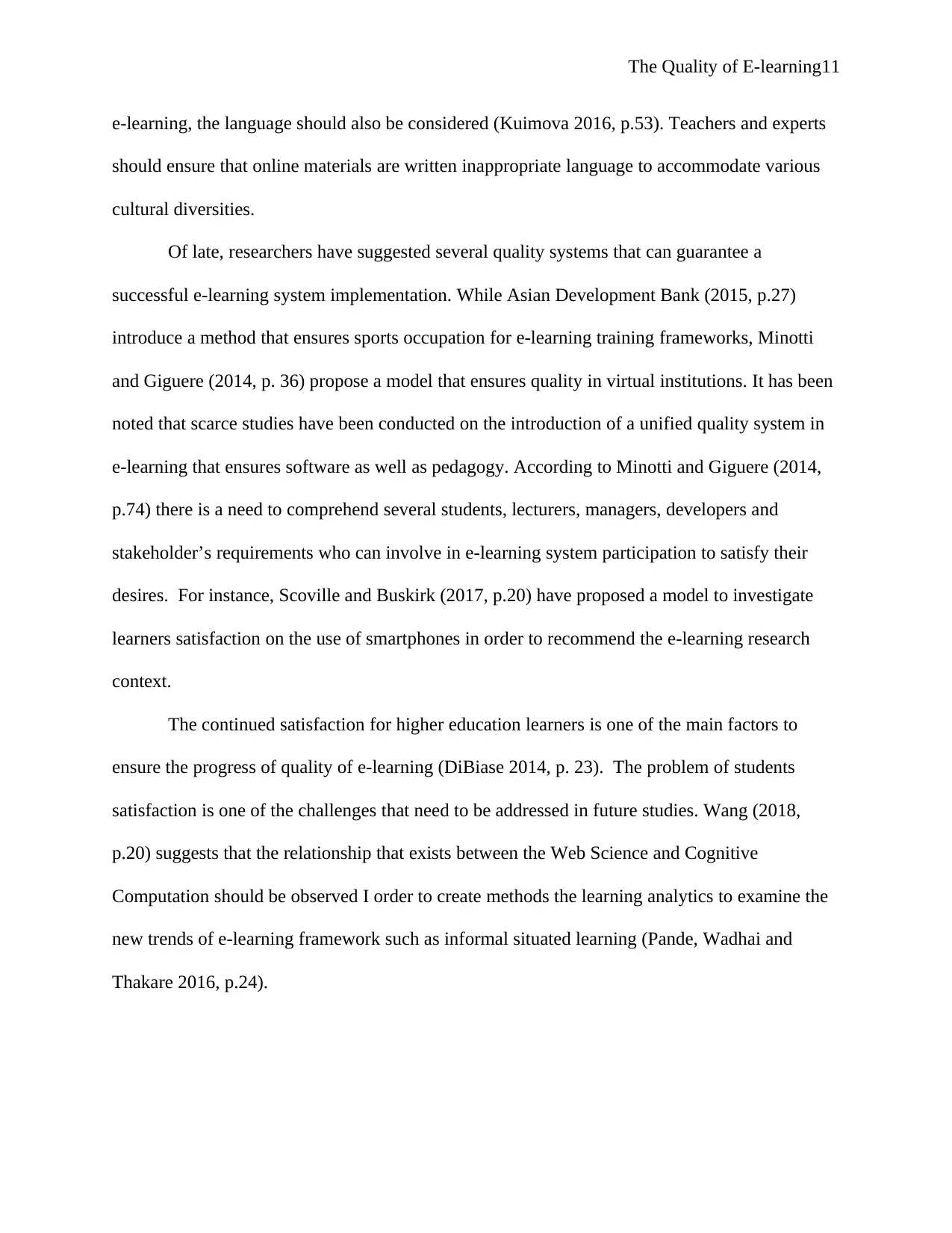
The Quality of E-learning11
e-learning, the language should also be considered (Kuimova 2016, p.53). Teachers and experts
should ensure that online materials are written inappropriate language to accommodate various
cultural diversities.
Of late, researchers have suggested several quality systems that can guarantee a
successful e-learning system implementation. While Asian Development Bank (2015, p.27)
introduce a method that ensures sports occupation for e-learning training frameworks, Minotti
and Giguere (2014, p. 36) propose a model that ensures quality in virtual institutions. It has been
noted that scarce studies have been conducted on the introduction of a unified quality system in
e-learning that ensures software as well as pedagogy. According to Minotti and Giguere (2014,
p.74) there is a need to comprehend several students, lecturers, managers, developers and
stakeholder’s requirements who can involve in e-learning system participation to satisfy their
desires. For instance, Scoville and Buskirk (2017, p.20) have proposed a model to investigate
learners satisfaction on the use of smartphones in order to recommend the e-learning research
context.
The continued satisfaction for higher education learners is one of the main factors to
ensure the progress of quality of e-learning (DiBiase 2014, p. 23). The problem of students
satisfaction is one of the challenges that need to be addressed in future studies. Wang (2018,
p.20) suggests that the relationship that exists between the Web Science and Cognitive
Computation should be observed I order to create methods the learning analytics to examine the
new trends of e-learning framework such as informal situated learning (Pande, Wadhai and
Thakare 2016, p.24).
e-learning, the language should also be considered (Kuimova 2016, p.53). Teachers and experts
should ensure that online materials are written inappropriate language to accommodate various
cultural diversities.
Of late, researchers have suggested several quality systems that can guarantee a
successful e-learning system implementation. While Asian Development Bank (2015, p.27)
introduce a method that ensures sports occupation for e-learning training frameworks, Minotti
and Giguere (2014, p. 36) propose a model that ensures quality in virtual institutions. It has been
noted that scarce studies have been conducted on the introduction of a unified quality system in
e-learning that ensures software as well as pedagogy. According to Minotti and Giguere (2014,
p.74) there is a need to comprehend several students, lecturers, managers, developers and
stakeholder’s requirements who can involve in e-learning system participation to satisfy their
desires. For instance, Scoville and Buskirk (2017, p.20) have proposed a model to investigate
learners satisfaction on the use of smartphones in order to recommend the e-learning research
context.
The continued satisfaction for higher education learners is one of the main factors to
ensure the progress of quality of e-learning (DiBiase 2014, p. 23). The problem of students
satisfaction is one of the challenges that need to be addressed in future studies. Wang (2018,
p.20) suggests that the relationship that exists between the Web Science and Cognitive
Computation should be observed I order to create methods the learning analytics to examine the
new trends of e-learning framework such as informal situated learning (Pande, Wadhai and
Thakare 2016, p.24).
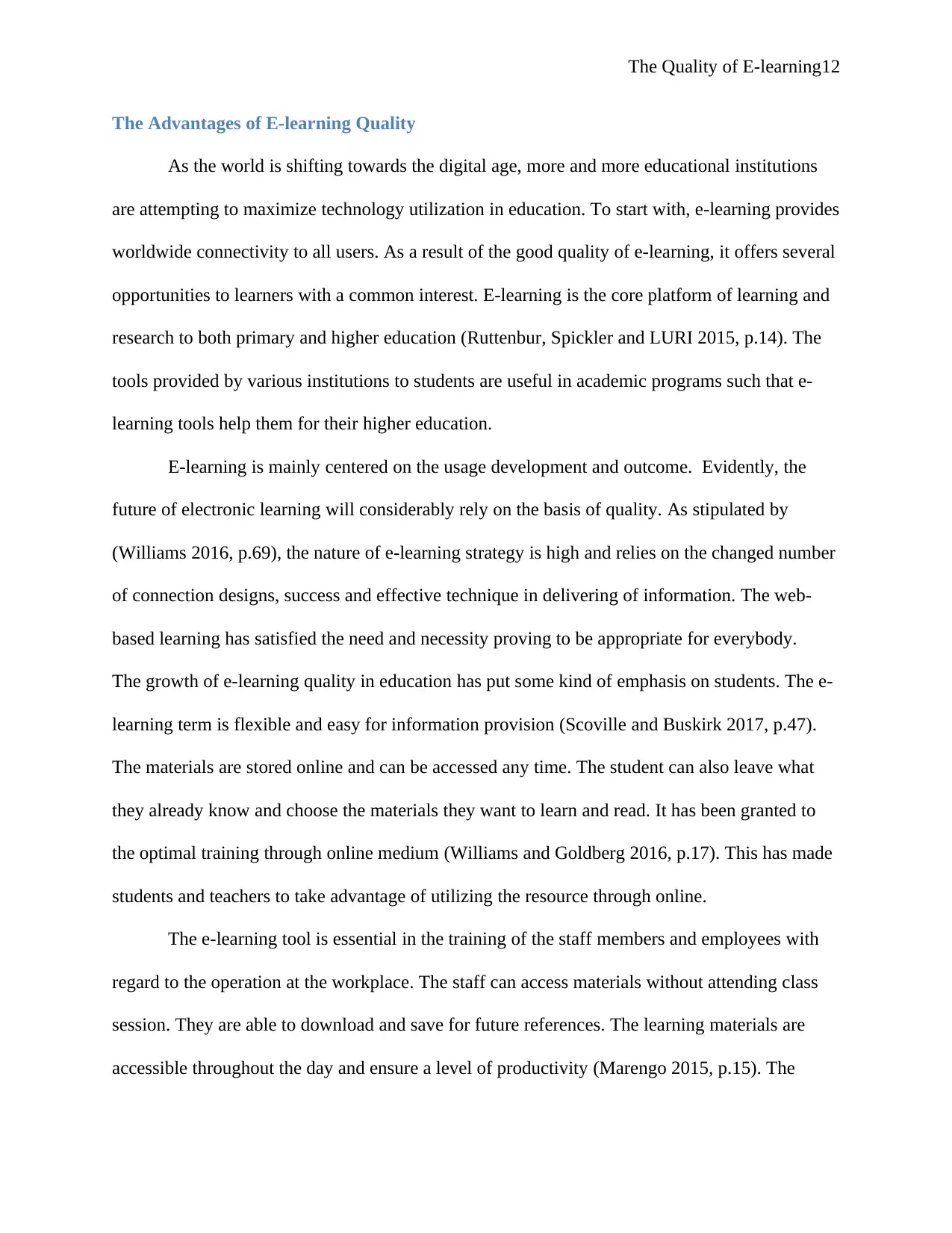
The Quality of E-learning12
The Advantages of E-learning Quality
As the world is shifting towards the digital age, more and more educational institutions
are attempting to maximize technology utilization in education. To start with, e-learning provides
worldwide connectivity to all users. As a result of the good quality of e-learning, it offers several
opportunities to learners with a common interest. E-learning is the core platform of learning and
research to both primary and higher education (Ruttenbur, Spickler and LURI 2015, p.14). The
tools provided by various institutions to students are useful in academic programs such that e-
learning tools help them for their higher education.
E-learning is mainly centered on the usage development and outcome. Evidently, the
future of electronic learning will considerably rely on the basis of quality. As stipulated by
(Williams 2016, p.69), the nature of e-learning strategy is high and relies on the changed number
of connection designs, success and effective technique in delivering of information. The web-
based learning has satisfied the need and necessity proving to be appropriate for everybody.
The growth of e-learning quality in education has put some kind of emphasis on students. The e-
learning term is flexible and easy for information provision (Scoville and Buskirk 2017, p.47).
The materials are stored online and can be accessed any time. The student can also leave what
they already know and choose the materials they want to learn and read. It has been granted to
the optimal training through online medium (Williams and Goldberg 2016, p.17). This has made
students and teachers to take advantage of utilizing the resource through online.
The e-learning tool is essential in the training of the staff members and employees with
regard to the operation at the workplace. The staff can access materials without attending class
session. They are able to download and save for future references. The learning materials are
accessible throughout the day and ensure a level of productivity (Marengo 2015, p.15). The
The Advantages of E-learning Quality
As the world is shifting towards the digital age, more and more educational institutions
are attempting to maximize technology utilization in education. To start with, e-learning provides
worldwide connectivity to all users. As a result of the good quality of e-learning, it offers several
opportunities to learners with a common interest. E-learning is the core platform of learning and
research to both primary and higher education (Ruttenbur, Spickler and LURI 2015, p.14). The
tools provided by various institutions to students are useful in academic programs such that e-
learning tools help them for their higher education.
E-learning is mainly centered on the usage development and outcome. Evidently, the
future of electronic learning will considerably rely on the basis of quality. As stipulated by
(Williams 2016, p.69), the nature of e-learning strategy is high and relies on the changed number
of connection designs, success and effective technique in delivering of information. The web-
based learning has satisfied the need and necessity proving to be appropriate for everybody.
The growth of e-learning quality in education has put some kind of emphasis on students. The e-
learning term is flexible and easy for information provision (Scoville and Buskirk 2017, p.47).
The materials are stored online and can be accessed any time. The student can also leave what
they already know and choose the materials they want to learn and read. It has been granted to
the optimal training through online medium (Williams and Goldberg 2016, p.17). This has made
students and teachers to take advantage of utilizing the resource through online.
The e-learning tool is essential in the training of the staff members and employees with
regard to the operation at the workplace. The staff can access materials without attending class
session. They are able to download and save for future references. The learning materials are
accessible throughout the day and ensure a level of productivity (Marengo 2015, p.15). The
⊘ This is a preview!⊘
Do you want full access?
Subscribe today to unlock all pages.

Trusted by 1+ million students worldwide
1 out of 24
Related Documents
Your All-in-One AI-Powered Toolkit for Academic Success.
+13062052269
info@desklib.com
Available 24*7 on WhatsApp / Email
![[object Object]](/_next/static/media/star-bottom.7253800d.svg)
Unlock your academic potential
Copyright © 2020–2025 A2Z Services. All Rights Reserved. Developed and managed by ZUCOL.





